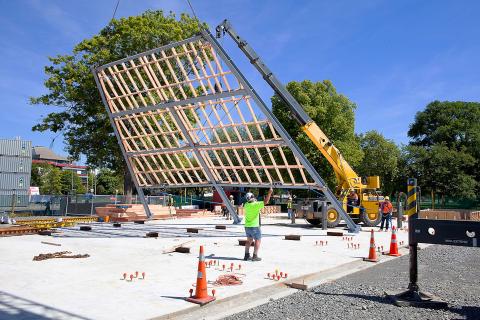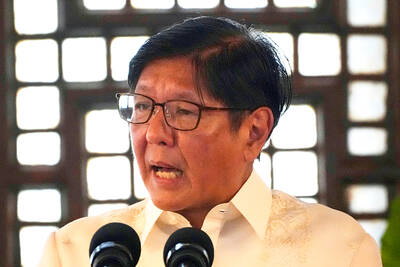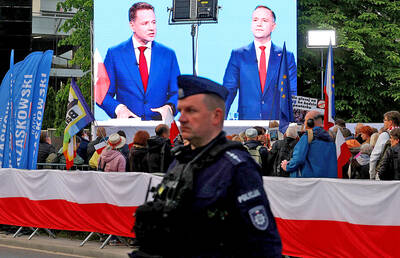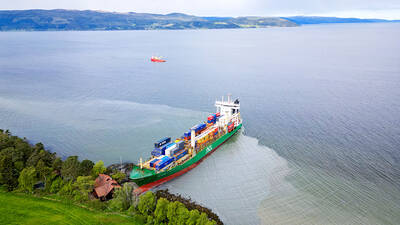When Japanese architect Shigeru Ban designed a new cathedral in earthquake-devastated Christchurch, he chose the most unlikely of materials — cardboard — for the landmark project.
The New Zealand city’s magnificent Gothic revival cathedral hewn from local basalt was irreparably damaged in the magnitude 6.3 earthquake that claimed 185 lives on Feb. 22 last year.
Urgently needing a temporary replacement, the Anglican Church commissioned Ban — who donated his services for free — to draw up plans for a place of worship to house Christchurch’s faithful.

Photo: AFP
The result is the so-called cardboard cathedral now taking shape on the quake-scarred city’s skyline.
Built from 600mm diameter cardboard tubes coated with waterproof polyurethane and flame retardants, it will be a simple A-frame structure that can hold 700 people.
“It will be a huge milestone towards recovery for Christchurch,” project manager Johnny McFarlane said. “It’s going to be a great building to walk into, it’s very light and airy and gives a good sense of dominance and scale.”
Ban, a world-renowned architect who has been hailed by publications such as the Wall Street Journal and Time magazine, sees the cathedral as a way his profession can help Christchurch’s shattered community recover from the quake.
While the 55-year-old takes on major commercial projects such as office buildings and tourist resorts, he is also a pioneer in “emergency architecture” which can be rapidly erected in disaster zones.
He began in the mid-1990s, working with the UN to erect temporary shelters for refugees after the Rwanda genocide and has since helped with relief efforts in scores of humanitarian emergencies from Turkey to his native Japan.
“This is part of my social responsibility,” he told reporters. “Normally we [architects] are designing buildings for rather privileged people ... and they use their money and power for monumental architecture. But I believe we should build more for the public ... people who have lost their houses through natural disaster.”
He said many so-called natural disasters such as earthquakes were worsened by the failure of man-made structures and architects had an obligation to help.
“People are not killed by earthquakes, they’re killed by collapsing buildings,” he said. “That’s the responsibility of architects, but the architects are not there when people need some temporary structure because we’re too busy working for [the] privileged. Even a temporary structure can become a home.”
A common feature of Ban’s emergency architecture is the use of recycled material, including shipping containers and beer crates, which were filled with sandbags to act as shelter foundations after the 1995 Kobe earthquake.
However, his signature material is cardboard tubes, which he says are readily available after disasters, unlike traditional materials such as timber and steel.
He has used them to build everything from a concert hall in L’Aquila, Italy, a schoolhouse in China’s Chengdu and a “paper church” in Kobe, which was erected in just five weeks.
“The material is available everywhere in the world,” he said. “Even when I was building a refugee shelter in Rwanda I found the paper I needed for my structure in Kigali. So anywhere I can go I can find this material, it’s very inexpensive and normally this is not a building material, so it’s easy to get in the emergency period. It’s also lightweight and cheap.”
Christchurch’s new cathedral, due to be completed in April next year — 132 years after the consecration of the original stone version — is the largest cardboard structure Ban has designed.
The church, insurance and public donations are paying for the NZ$5 million ($4.2 million) project for which local builders have offered discount prices.
It has a concrete base, with the cardboard tubes forming two sides of the A-frame and containers helping brace the walls.
One end of the cathedral will be filled with stained glass and a polycarbon roof will help protect it from the elements, giving a lifespan estimated at 50 years.
Church authorities envisage it being used as a cathedral for only 10 years, until a permanent replacement is built, although Ban said the enthusiastic response in New Zealand to his innovative plans could change that.
“If people love it, it will be permanent, I hope that’s going to happen,” he said.
Building authorities in Christchurch pored over the plans and declared they fully meet earthquake standards, while even locals initially skeptical about the cardboard concept have been won over.
“I thought it was a bit of a strange idea, but now I think it’s really cool,” Christchurch resident Hunter McKenzie said. “It’s actually good just to get the cathedral up and running and try to get the city back to normal.”

NO EXCUSES: Marcos said his administration was acting on voters’ demands, but an academic said the move was emotionally motivated after a poor midterm showing Philippine President Ferdinand Marcos Jr yesterday sought the resignation of all his Cabinet secretaries, in a move seen as an attempt to reset the political agenda and assert his authority over the second half of his single six-year term. The order came after the president’s allies failed to win a majority of Senate seats contested in the 12 polls on Monday last week, leaving Marcos facing a divided political and legislative landscape that could thwart his attempts to have an ally succeed him in 2028. “He’s talking to the people, trying to salvage whatever political capital he has left. I think it’s

Polish presidential candidates offered different visions of Poland and its relations with Ukraine in a televised debate ahead of next week’s run-off, which remains on a knife-edge. During a head-to-head debate lasting two hours, centrist Warsaw Mayor Rafal Trzaskowski, from Polish Prime Minister Donald Tusk’s governing pro-European coalition, faced the Eurosceptic historian Karol Nawrocki, backed by the right-wing populist Law and Justice party (PiS). The two candidates, who qualified for the second round after coming in the top two places in the first vote on Sunday last week, clashed over Poland’s relations with Ukraine, EU policy and the track records of their

UNSCHEDULED VISIT: ‘It’s a very bulky new neighbor, but it will soon go away,’ said Johan Helberg of the 135m container ship that run aground near his house A man in Norway awoke early on Thursday to discover a huge container ship had run aground a stone’s throw from his fjord-side house — and he had slept through the commotion. For an as-yet unknown reason, the 135m NCL Salten sailed up onto shore just meters from Johan Helberg’s house in a fjord near Trondheim in central Norway. Helberg only discovered the unexpected visitor when a panicked neighbor who had rung his doorbell repeatedly to no avail gave up and called him on the phone. “The doorbell rang at a time of day when I don’t like to open,” Helberg told television

‘A THREAT’: Guyanese President Irfan Ali called on Venezuela to follow international court rulings over the region, whose border Guyana says was ratified back in 1899 Misael Zapara said he would vote in Venezuela’s first elections yesterday for the territory of Essequibo, despite living more than 100km away from the oil-rich Guyana-administered region. Both countries lay claim to Essequibo, which makes up two-thirds of Guyana’s territory and is home to 125,000 of its 800,000 citizens. Guyana has administered the region for decades. The centuries-old dispute has intensified since ExxonMobil discovered massive offshore oil deposits a decade ago, giving Guyana the largest crude oil reserves per capita in the world. Venezuela would elect a governor, eight National Assembly deputies and regional councilors in a newly created constituency for the 160,000